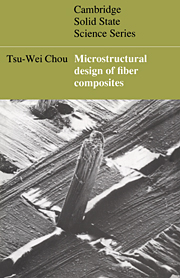Book contents
- Frontmatter
- Contents
- Preface
- 1 Introduction
- 2 Thermoelastic behavior of laminated composites
- 3 Strength of continuous-fiber composites
- 4 Short-fiber composites
- 5 Hybrid composites
- 6 Two-dimensional textile structural composites
- 7 Three-dimensional textile structural composites
- 8 Flexible composites
- 9 Nonlinear elastic finite deformation of flexible composites
- References
- Author index
- Subject index
5 - Hybrid composites
Published online by Cambridge University Press: 10 December 2009
- Frontmatter
- Contents
- Preface
- 1 Introduction
- 2 Thermoelastic behavior of laminated composites
- 3 Strength of continuous-fiber composites
- 4 Short-fiber composites
- 5 Hybrid composites
- 6 Two-dimensional textile structural composites
- 7 Three-dimensional textile structural composites
- 8 Flexible composites
- 9 Nonlinear elastic finite deformation of flexible composites
- References
- Author index
- Subject index
Summary
Introduction
The term ‘hybrid composites’ is used to describe composites containing more than one type of fiber materials. Hybrid composites are attractive structural materials for the following reasons. First, they provide designers with the new freedom of tailoring composites and achieving properties that cannot be realized in binary systems containing one type of fiber dispersed in a matrix. Second, a more cost-effective utilization of expensive fibers such as carbon and boron can be obtained by replacing them partially with less expensive fibers such as glass and aramid. Third, hybrid composites provide the potential of achieving a balanced pursuit of stiffness, strength and ductility, as well as bending and membrane related mechanical properties. Hybrid composites have also demonstrated weight savings, reduced notch sensitivity, improved fracture toughness, longer fatigue life and excellent impact resistance (Chou and Kelly 1980a). Some of the pioneering studies on this topic can be found in the work of Wells and Hancox (1971), Hayashi (1972), Kalnin (1972), Hancox and Wells (1973), Bunsell and Harris (1974), Harris and Bunsell (1975), Walton and Majumdar (1975), Aveston and Sillwood (1976), Bunsell (1976), Harris and Bradley (1976), Zweben (1977), Arrington and Harris (1978), Badar and Manders (1978, 1981a,b), Marom, Fischer, Tuler and Wagner (1978), Rybicki and Kanninen (1978), Summerscales and Short (1978), Aveston and Kelly (1980), Wagner and Marom (1982), Fukuda (1983a–c), and Harlow (1983).
Depending upon the arrangements of fibers and pre-preg layers, hybrids can be categorized into the following types. In the first type the different fiber materials are intimately mixed together and infiltrated with a matrix simultaneously.
- Type
- Chapter
- Information
- Microstructural Design of Fiber Composites , pp. 231 - 284Publisher: Cambridge University PressPrint publication year: 1992
- 1
- Cited by

